Who Framed Roger Rabbit is one of those films that is great for both kids and adults. For the children, the premise is about cartoon characters who live in the real world, which is basically every playground dream ever come to life. It also combines both Disney and Warner Brothers characters in one film, a glorious crossover that audiences had never seen before and are unlikely to see again. (The rights issues were a nightmare.) For the adults, the words of Eddie Valiant say it best: the tale is primarily one of greed, sex, and murder. It’s film noir fun for the whole family!
This was one of my favorite movies as a child, but I have to admit, if you stop for even a moment to consider the reality of the world these characters occupy… it is deeply screwed up.
So let’s start by talking about the toons. Where did they come from in the first place? It seems oddly safe to assume that humans are still responsible for creating them, particularly when we consider Jessica Rabbit’s famous line: “I’m not bad, I’m just drawn that way.” It could be a figure of speech, sure, but it’s more likely that toons are first “drafted” into existence by people and then get lives of their own. In that case, animation is a very different job in this universe. You’re more like a mad scientist, creating a new creature and releasing it unto the world.
And what are the toons created for, exactly? Why, to entertain us, of course!
Wait, what?
As far as we see, toons who make bank do so by starring in cartoons. That’s it. That’s the one way that you do well as a toon in our world. The ones who don’t work much in entertainment likely pay the bills by taking positions in Toon Town, doing jobs that you would normally find in the non-animated world as well—postal workers, vocal coaches, bankers and the like. They don’t get to take those jobs outside of Toon Town, however. They work within clearly defined parameters set up by flesh and blood people because we don’t want them taking human jobs and working in human businesses.
Can you see me waving to the uncomfortable allegory as it waltzes by?
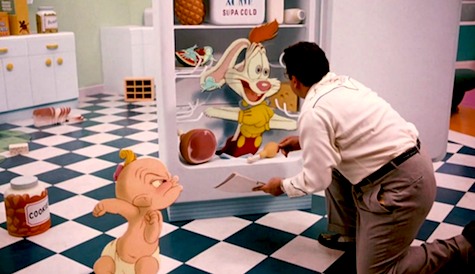
It gets worse: Eddie first sees Roger’s wife Jessica working at a place called The Ink and Paint Club. It’s a revue venue where toons can perform, but only humans are allowed in as patrons. It’s also a pretty handy stand-in for places like the Cotton Club in Harlem, New York where some of the greatest black jazz players performed for a whites-only audience. The toons are allowed to work the floor at the Ink and Paint as well (even poor Betty Boop has a gig as a cigarette vendor there now that her work has dried up), but certainly not to sit down and watch the show.
If you need further proof of their sub-human status, you need only look at how they are treated by their creative peers. In the opening of the film, when Roger can’t produce the correct reaction to having a refrigerator dropped on his head, he begs the director to try the take again, claiming he can handle it. The director’s response? “I’m not worried about you, I’m worried about the refrigerator!” Yes, Roger is incapable of being permanently injured by the fridge, but it’s hard to believe that there are no traumatic effects involved with consistent abuse, even if they are psychological rather than physical.
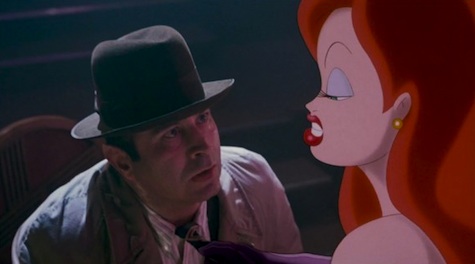
Roger’s wife, Jessica, is another perfect microcosm of exactly what’s wrong with their society. Without the ability to change due to the way she is “drawn,” Jessica is incapable of altering the way people perceive her. She’s a femme fatale, made to be sensual and enticing, but that’s only how she appears; it tells us nothing about who she is. She is an exacting metaphor for how women are constantly judged at face value. The fact that she is smart and capable and appreciates humor—she married Roger because he makes her laugh—is irrelevant because the way she looks determines what everyone assumes of her. She is used precisely for her sex appeal at the beginning of the film, in a game of blackmail between R.K. Maroon and Marvin Acme. Then she spends the rest of the film trying to protect her husband, but when she comes to Eddie with her story about what happened, he initially doesn’t believe her. Why? Because she doesn’t exactly look the part of loving, devoted wife.
(Aside question: Is Roger and Jessica’s marriage as a rabbit and a woman an interspecies one if they’re both toons? I can’t quite decide there….)
Are toons pre-programmed to their detriment in this world? When Judge Doom is trying to find Roger in Delores’ bar, he manages it by tapping out the rhythm to the first half of “Shave and A Haircut.” Roger is physically incapable of leaving the call unanswered and promptly gives himself up. It’s meant to be hilarious—and of course it is—but not having the free will to stay silent when your life is in danger isn’t exactly chuckle-worthy. What about their predicament with the handcuffs? It plays as though Roger pretends he can’t slip them so that he can get Eddie to stick by him, but when Eddie asks as much, Roger’s response is that he could only get out of them “when it was funny!” And for all we know, that might truly be the case.
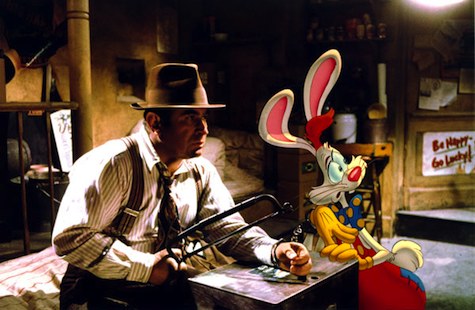
Similar questions are raised when Eddie gets Roger to drink alcohol, prompting the attack that allows them to escape their first joint encounter with Doom. Roger already knows what alcohol does to him (we see its effects earlier in the film) and doesn’t want the shot. The way that Eddie gets him to gulp it down is by employing the old “reverse the back-and-forth argument” trick. Roger gamely switches along with him, then takes the drink. So the question returns: Is that cue built into Roger’s being by virtue of being a toon? Are all toons required to respond the same way to those arguments, and how terribly can they be taken advantage of if that’s the case?
The alcohol itself poses an interesting question; Roger’s response to human liquor is straight out of a cartoon—he effectively goes nuclear, steaming and shrilling like an alarm. Does the rabbit have an allergy to human alcohol, or is he made to respond to real world environments as though he’s still in a cartoon? And what purpose could that possibly serve practically, except to make toons consistently amusing even when they’re off the clock? It only helps Roger by accident, after all. And as he says to Eddie halfway through the film, “My whole purpose in life is to make people laugh.” Because it literally is.
There’s Eddie’s initial hatred of toons to contend with at the start of the film, which is prompted by the death of his brother at the hands of the Judge years ago. While we can sympathize with Valiant’s pain, the fact that he proceeds to view all toons as despicable smacks of “someone who drove a Mitsubishi hit my dog with their car and now I hate all people who drive Mitsubishis.” Or, obviously, of far more serious types of prejudice that human beings have to suffer through every day.
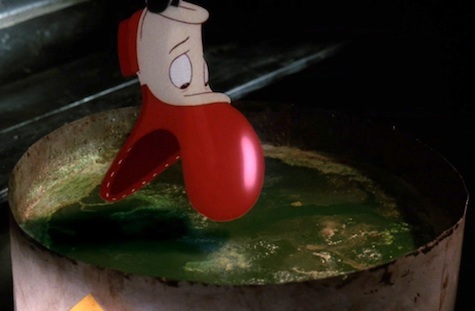
But the place where things get truly unsettling unfolds when Judge Doom is put under the microscope. Doom introduces himself under the guise of a human judge who has made it his responsibility to bring toons to justice, and he appoints himself as the law in its entirety where they are concerned. As far as we see, the judge has been given dispensation to handle toons however he sees fit; with the creation of Dip, that means he is allowed to murder them without due process, for any reason he deems reasonable. (As when he dips a lone cartoon shoe for no reason other than to prove the deadly liquid’s power.)
Some people in the film seem uncomfortable at Doom’s methods, but they never lift a hand to stop him. Also take into account that no one is regulating the production of Dip but him, which is essentially like allowing a private contractor to develop a chemical weapon in secret and then use it on a portion of the population indiscriminately. No one takes a careful look into what Doom is doing—no sneaky reporters, no crafty cops, no lawyers for toon rights. No one but Eddie, and he’s a damn hard sell to begin with. Not to mention that he only gets involved because he was initially hired to prove Roger had killed a human. Toon justice isn’t on anyone’s radar, and we can’t be sure if it’s because people are a-okay with how they’re treated, or just happy to stay uninformed. Probably a mix of both.
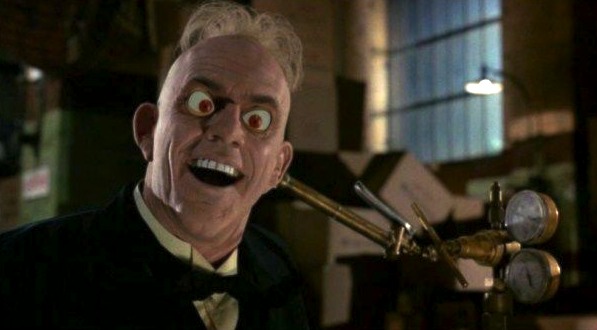
And what about Doom’s true identity as a toon himself? We have no clue what made him fly the cuckoo’s nest, going to such incredible lengths to serve a vision and obliterate Toon Town. You could flag him as flat out crazy and not assign any motive, but he sort of demands it. He’s a toon who prefers to disguise himself as a human and figures out the only way to kill other toons. The freeway plan is a nice, weirdo excuse that plays into humanity’s fear of industrialization and modernization, but that’s not what he’s really after—he’s created a reason to dip every single one of them. To commit genocide on his own kind. And what would make him want to do that? Could it have something to do with the reasons why he prefers to wear a mask that allows him to pass for one of us?
The picture all this paints is horrifying, a world where sentient beings are treated as non-persons, their lives worthless beyond their ability to humor us. With that in mind, the end of the film is more than just a relief for Roger and Jessica—not only are the lives of all toons spared, but Acme’s will makes certain that they will have far more control over their future now that Toon Town belongs to them. Still, it doesn’t ensure their protection from murder, or a fair shake when they’re accused of one themselves. That job is apparently still Eddie Valiant’s purview, and it’s a good thing that he managed to put his brother’s death behind him because they’re in dire need of his help.
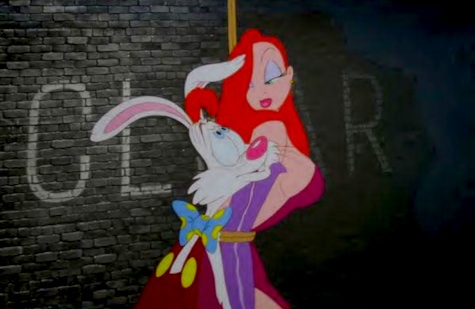
Which is not to say that this should be on everyone’s mind whenever they watch Who Framed Roger Rabbit at all. Merely that picking apart that colorful place offers a lot more blam-pow for your buck if you decide to take it seriously. Because Roger’s right—sometimes in life, laughter is the only weapon we have. And by delivering those laughs, the film bearing his name can help ward us against what’s really going on in Toon Town.
Emmet Asher-Perrin still can’t handle that shoe getting dipped—mainly because its pair is still out there somewhere all alone. She was recently on the Geeks Guide to the Galaxy podcast talking about Star Trek Into Darkness, and an essay of hers can be found in the newly released Queers Dig Time Lords. You can bug her on Twitter and read more of her work here and elsewhere.










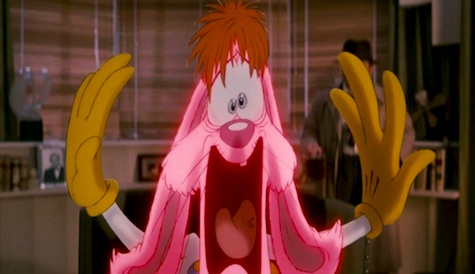
It is horrifying upon any examination for a reason. I think that the metaphors very much are the message here.
It’s also significant that the only other jobs we see toons doing aside from entertainment are low-level service jobs: Betty Boop’s cocktail waitress, the elevator operator in Toontown, the cab.
I love this article.
Comedy is tragedy from a distance, or with a twist. Any cartoon universe is pretty horrifying when you think about it. Elmer Fudd is perfectly within his rights to hunt, kill, and eat sentient beings who happen to be wabbits or ducks. One Disney comic book once showed a relative of Donald Duck hunting other, less anthropomorphic yet still sentient and talking ducks for food. Tom, Jerry, and Spike are engaged in a relationship of unending domestic abuse. Scooby-Doo takes place in a town where most of the adults are crooks and liars using supernatural scams to defraud their neighbors, and the only legal protection the citizenry has is a small band of teens and their inexplicably verbal dog.
@2, There are implications that there are higher class jobs, some toons have to be working at/own the toon bank Doom robs in Eddie’s backstory.
Then again, perhaps Acme owns the toon bank, then the implications are even more disturbing.
It’s been years since I saw Roger Rabbit but, when you start breaking it down…I was about halfway through the article and, in my head, replaced “toons” with “robots” and thought I was reading about I, Robot or Blade Runner.
It is the L. A. Confidential of children’s movies. :)
Great article!
A dystopian setting is an essential part of the noir formula. From Red Harvest where literally everyone in town is a crook (chief of police & little old ladies included), to the ultraviolent pulps, to Chinatown, to Neuromancer, the dark and violent and unforgiving world comes with the territory.
I never thought of it before until this article, but WFRR is another example of the great genre trope of showing the audience a spec-fic world through the lens of a murder mystery. It’s an excellent way to navigate the weird and unique scenery; great examples that come to mind include Red Mars, The City & the City, Yiddish Policeman’s Union, The Dresden Files.
This is…disturbing.
And if all Toons were created purely for human entertainment–then were the Jessica Rabbits and Betty Boops really created for “comedy”?
We all know how slaves were treated by slave masters and even “free” houseworkers by their employers in the not so distant past.
It ay add to the discussion that, in the original novel by Gary Ross, the word “toon” was coined specifically as a stand-in for a very offensive racial slur with a different initial consonant. I assume if I type it I will be blocked, but you can probably all figure out what it is.
Bringing something else to the discussion that my mom said way back when WFRR was first released–do humans feel comfortable abusing Toons because it allows them to compensate for their fundamental insecurity re: Toons’ effective immortality? Is that the best in-universe explanation for the authorities’ ignoring Dip–that the humans are all basically relieved to finally have a way to take away the Toons’ one real, enviable advantage over them?
(P.S. The formula for Dip is basically really strong paint thinner, like you might use to wash a cel–further evidence for the animator-as-cruel-mad-scientist part of this analysis.)
@9. wcarter
What your implying immediately brings to mind the movie “Cool Town” where it’s made clear there are dire consequences for sexual relations between humans and toons. (We see Brad Pitt as a detective in romantically emotional, but non-sexual relationship with a toon, just in case anyone needed a bit more referencing) I too get the feeling that characters such as Jessica Rabbit and Betty Boop were created for far less savory reasons than comedy, whether or not the humans in the world of WFRR actually act upon it, or seek just the visual stimulant.
@6: The same thoughts occurred to me (and immediately made me think of A.I.).
As much as a cartoon is a caricature of a real object, so the toons in WFRR were supposed to be caricatures of real social concepts, ie, racial discrimination, ghettoization, inequality, etc. The fact that the object of these issues is, in this case, an imaginary race allows the viewer to understand the implications, yet at the same time turn a blind eye to them (as no real people are being harmed–like in a cartoon) and enjoy the story.
Really, that’s the entire point of most American cartoons, and to an extent, movies, teleplays and theatre… we the audience KNOW no one’s really being hurt, it’s just acting. But it’s still supposed to draw the comparison to real people being hurt, with the idea of drawing an emotional (or rational) reaction out of us. Recall Alien Nation? It accomplished the same social examination, but with made-up actors instead of toons.
Movies like WFRR at least remove the idea that a real person, ie, a Bill Bojangles Robinson or a Pamela Anderson, is either willingly or unwillingly being forced to portray themselves as a caricature or stereotype of their race, sex, etc, for others’ amusement. But as far as our internal sympathies are concerned… they are all the same.
The good news this article raises is that, no matter how the message is dressed up, we still recognize it and register its impact.
I have a friend who *hates* this movie because of how downbeat the universe is. I always respected it (a lot; I saw it in the theater 9 times as a kid) becuase it showed a world that made sense if we – people – were expected to share space with beings who were, for all intents and pruposes, immortal
@11, OMG I haven’t seen that movie in so long!! In Cool World, the toon would become human if they had sex with a human. Now the implications of THAT in WFRR are mind bogling.
Great article. I don’t know how far I agree with all the points, but I always thought of Roger Rabbit as in part a commentary on the social changes that came after World War II, changes that were highly reflected in Hollywood, and of course included race, and later, gender.
And no, Jessica and Roger are not an interspecies couple, both being toons. Though I don’t know what the heck their kids would look like… Now, anything Jessica might do with a human….that’s definitely interspecies, despite her looking more like a woman than a rabbit.
I always assumed, since toons were drawn, that conception between toons wasn’t possible, which is why the distinct difference between Jessica and Roger wasn’t an issue.
Plus then toons could create themselves, and then what would happen?
Disturbing to think about, yes, but also a highly amusing article. Thanks for this.
@16: Well, judging from the available evidence, conception between toons typically results in multiple offspring who look and act like miniature versions of one or the other parent. Sometimes the result will be a hybrid of both parents’ attributes.
Also, the toon procreative process typically involves the intervention of a stork. Pregnancy does not seem to be involved, though avian toons do lay eggs.
Interesting article, and for the most part I’d have to say I agree. I haven’t seen the movie in several years and I doubt at the time I was fully aware of the many levels on which the film operates. One question I will throw out there is whether the toons could truly be called sentient beings if they can only act to fit how they’re drawn. The dictionary says that sentience is the ability to feel or respond emotionally instead of intellectually. (Which is a very interesting definition, but that’s a discussion for another time.) A similar question would be if you can call a computer intelligent when it’s only doing what it has been programmed to do. It might be a really, really good program that simulates intelligent behavior, but is that in itself intellegence? For the toons, are the feelings they express real or just creations of the artists? How much free will do they have? Could an artist create a toon with free will? If Jessica is drawn “bad”, is she also drawn to love Roger and act on that love or is that an example of a toon going against their programming (for lack of a better word)?
I obviously don’t have answers to any of these questions, but I love that the article here at least caused me to think about the implications of it all. Nice work.
Good stuff. I’m currently slogging through david graeber’s ‘debt: the first 5000 years’ so i’m thinking there has to be some great links between the two. Unfortunately that’s about as far as my smarts will go down that rabbit hole but surely the humans in this world place the toons under a debt to entertain them since, y’know, they gave them life to begin with. So are they a slave race? They are created to be objectified – it all gets a bit meta where the animators of the film itself slipped in a supposedly explicit scene where jessica falls from the toon car.
Imagine a human boot stamping on a toon’s face forever…
Good article, but I would put forward that the universe of WFRR is far cheerier than the universe of the novel Who Censored Roger Rabbit. Another coment has raised the point that the ‘Toons in WCRR seem to be a racian stand in. (Substutute one letter in Toon and you’re there.) What’s worse is that throughout the entire novel there is no one redeemable or admirable Toon character. They are all, including Roger, low-lifes, and untrustworthy. jessica in the novel is a Toon from the simple blakc and white porn chapbook industry. It felt as though the author was truly to make some vile and racist comments and hid them behind his fantastic setting.
it is a book that made me feel unclean for having read it.
@19: Yes, “sentient” doesn’t so much mean intelligent as having conscious awareness and sensation. Fiction like Star Trek tends to conflate it with “sapient,” meaning intelligent, but they aren’t necessarily the same thing. Indeed, animal studies in recent years have suggested that many, even most animals are more sentient, more aware of their existence and the world around them, than we’ve generally assumed.
As for free will vs. programming, the movie seems to strike a middle ground between the performer hypothesis — that toons are actors playing scripted roles — and the interpretation that they really are how they’re portrayed onscreen. Although that’s not uncommon. A number of Warner Bros. cartoons, including more recent movies and shows, have defined the Looney Tunes as performers who have a life offscreen, but they seem to be pretty much playing themselves onscreen, so Daffy Duck really is just as egomaniacal as in his cartoons, Porky Pig really does stutter, etc. Ditto with the Muppets.
I guess the concept of WFRR is that these characters were created by the imagination, but the emotion or belief instilled in them brought them to physical life and reality. So they’re independent beings, but they were designed to have certain personalities and proclivities. Can they resist or transcend those traits? Probably, as with humans, it depends on the individual — how comfortable they are with their identity, how much willpower or incentive to change they have, etc. Roger’s innate personality is that of a comedian, someone whose purpose is to make people laugh, and he genuinely likes that identity, so he’s embraced it and become committed to it rather than trying to grow beyond it. Jessica, like many women whom genetics have endowed with stunning beauty and sex appeal, may have gotten tired of being seen only in those terms and wanted to do more with her life. Indeed, as a character designed pretty much exclusively for being ogled at by toon and human audiences (assuming her cartoon role was like that of her inspiration, Tex Avery’s Red Hot Riding Hood), that means she would’ve been pretty much a blank slate otherwise and would’ve been free to develop whatever personality she wanted on top of her reflexive seductiveness. And Baby Herman would’ve had plenty of incentive to develop a life beyond the limiting role of a helpless infant, even to rebel against it, which could explain why he, unlike Roger, is so completely the opposite of his screen persona.
You break it down so much so that it makes me want to cry! Now I’m going to have a hard time not overthinking everything about it the next time I watch! Loved the article though! haha
Like the best of entertainment, this movie mixes comedy and tragedy. There is a lot of resonance here with the less than admirable attitudes some people have towards those they assume to be less than themselves. The slapstick makes you laugh, but the movie also makes you think…
Easy to see the parallels between Toons and fairy tales. Violent, written for entertainment, loaded with metaphors.
Though I think it’s a lot less intentional than in WFRR, a lot of kids’ movies and shows raise questions along these lines. Like in Toy Story – all the toys are so happy to belong to Andy, find fulfillment in belonging to a kid, etc. Then there are all the “talking animal” type shows. If your pet dog is actually as sentient and sapient as you are, is it ethical to keep it as a pet?
Roger Rabbit is a brilliant, brilliant film and I honestly can’t figure out how the hell they pulled off the licenses AND the leeway to use them in such a dark, violent way.
This article puts me in mind of two very different yet equally striking works of fanfiction, both of which explore(d) — to varying degrees, and with a considerable amount of multi-toned humor along the way — the ethics and psychological dimensions of Toons interacting with the “real world”.
One of these originated on the GEnie online service — a competitor of Prodigy and CompuServe in the pre-Web era — as a sprawling, multi-threaded, group-written epic titled variously “Carrot Juice, Earl Grey, Hot”, or “Bugs Bunny vs. the Borg”. Nominally a direct sequel/parody to ST:TNG’s “The Best of Both Worlds”, it initially focused on the classic Merrie Melodies characters but eventually expanded to include nearly every kids’ cartoon character known to man at one point or another. [Not only did the toon characters win, they eventually got their own planet.] “Carrot Juice, Earl Grey, Hot” is unique, in large part because the GEnie message board structure was unusually well suited to a very particular sort of collaborative storytelling. Regrettably, the last I looked the only online source of the text lies in the depths of the Wayback Machine.
The second is somewhat more recent; “The Merry-Go-Round Broke Down” is a direct sequel to WFRR, picking up the thread in a newer age of animation and wearing its metafictional agenda even more openly on its sleeve than the film itself did — all while maintaining a level of comic insanity even more dizzyingly warped than the film. Not surprisingly, it was a product of the annual Yuletide fanfiction exchange, which regularly demonstrates why the best fanfic is much, much more inventive and worthwhile than it’s often given credit for being.
showing the audience a spec-fic world through the lens of a murder
mystery. It’s an excellent way to navigate the weird and unique scenery
A trick also pulled off by Martin Cruz Smith in “Gorky Park” – he actually has his investigator explain to another character that he became an investigator because it gives you a chance to take the front off people’s homes and look inside at how they live.
The freeway plan is a nice, weirdo excuse that plays into humanity’s fear of industrialization and modernization
It’s also, of course, a) based on reality – the conspiracy to shut down the LA streetcar system in the 40s – and b) a lift from Chinatown.
This was one of my favorite movies as a child, and one of those things that I think may have formed my sense of humor. Even as a child, I could tell this was not a typical children’s movie and that there was something dark under the surface going on. I did not think to articulate it as well as you though. I definitely remember realizing more things as I got older – picking up more of the subtleties. As a child I’m pretty sure the streetcar plot completely bored me/went over my head, and it wasn’t until I was older that I realized what was going on with that and how it related to the rest of the movie.
Also, I am extremely sleep deprived this morning, but CLB’s comments at 4, as well as his matter of fact explanation of toon phenotypes in 18 made me laugh out loud and almost spurt coffee on myself. Nice way to start the morning.
Re: licensing as in @28: I don’t know every gory detail of negotiations, but I do know that Warner Brothers’ terms included a clause that Donald Duck and Daffy Duck had to have identical screen time to the second, and that the same had to go for Bugs Bunny and Mickey Mouse. The fact that the storyboard artists came up with such hilarious and in-character scenes in line with these contractual restrictions is a real high point.
Whatever my problems with Disney as a hyperacquisitive megacorporate behemoth, the fact is that only they could’ve possibly had the clout (and the truckloads of money) to convince so many of their competitors to license out their characters for the film.
Although immense credit must be given to director Richard Williams for insisting on portraying the characters’ appearances and personalities as they existed in 1947, despite studio pressures to use their modern, marketing-approved character models. That was a hard-fought battle and he won it.
(It’s also fortunate that Mel Blanc and Mae Questel were still around to portray their original characters — although Blanc’s voice wasn’t in good enough condition to handle Yosemite Sam and Foghorn Leghorn, so Joe Alaskey played them.)
cool town….
it hasent even begun to become the “real” future yet…:) –roger rabbit like trix was for kids….
cool town, messy and batshit bakshi.. was soo ahead of its conceptual time… it showed the multitasking, texting adhd generation off before the public had a clue… and its mish mash of the real and virtual can be seen today on any tokyo street…. and within the decade on mainstream walmart usa….
There’s a reason why the film was set in the 30’s (or so)… most of the attitudes and processes being described in this article were present for real back then. Just not towards toons…
Even as a kid, this movie creeped me out. It had such a dark undercurrent. Roger annoyed me, but more than that, something just bothered me and I couldn’t really describe what. I think this article finally clarified some of those issues for me.
It’s almost as if a noir detective film might have intentionally explored the dark side of human nature.
;-)
People spend too much time looking for ways to be offended than anything else.
I never did find this movie or its characters funny. I’ve watched it long ago, only once, but that was more than enough for me. It has always creeped me out for very vaguely defined reasons. Thanks for defining those reasons.
The book (which the movie was based on) makes all these themes far more explicit and disturbing.
@42: I found the book far less enjoyable and more bizarre. Its toons were newspaper comic strip characters, not animated cartoon characters, and when they spoke, voice bubbles materialized over their heads and people had to read them. (I believe it was easy to read their thoughts in the same way.) And they were able to produce short-lived copies of themselves to serve as “stunt doubles” for when they got blown up/smashed/etc., which makes far less sense for comic-strip characters than for animated ones. Sure, there was a lot of slapstick in older comic strips, but the book was set in the present.
Watched this years ago when it first came out, then re-watched it recently with my 10-year old daughter, who loved it. My wife gave up after about the first 15 minutes. It was definitely too dark for her, and a lot darker than I remembered. A lot of the reasons for the darkness were self-evident, but this article really delves into the subject and makes a convincing argument for its assertions. Internet analysis often goes overboard and speaks more about the writer’s own obsessions than it does about the subject in question. That is NOT the case here. Thanks!
An interesting point is that of the toon creation:
nobody question who created the villain, his motives, and wheter it can or cannot create another one again
An interesting point is that of the toon creation:
nobody question who created the villain, his motives, and wheter it can or cannot create another one again
Ok folks…look at the poster in RK Maroons office when Eddie first gets the assignment. There is a poster of a cartoon called Pistol Packing Possum. The pistol, cloak and hat all match Judge Doom. Even the color of the possum matches Judge Dooms paint as he is dipped. He is the toon who is surpassing his “programming” and rebelling against his existance. He kills both human and toon alike. Defies his fate and even changes his shape from possum to human form. He’s the first rogue toon.
In effect, toon town is given to the toon’s by Marvin Acme to avoid other toons from taking this route.
Toon town existed back in the 40’s according to WFRR, but where is it now? A dimension all to itself, closed off from humans just like Cool World.
@47, That’s backed up by Space Jam, but by Back in Action, they are back in our world again.
@48: I doubt those are meant to be in continuity with one another.
Actually there’s a long tradition of treating the Warner Bros. cartoon characters as actors who exist in our world alongside humans, stretching from the early Daffy/Porky short You Oughta Be in Pictures through Animaniacs and Back in Action.
While these are all valid points and ive never thought about the movie in relation to the toon’s civil rights being abused ive always seen this movie as more of a tongue in cheek history lesson of my home Los Angeles. We literally had the best public transportation system in the world, scenic views to rival venice and paris and while far from innocent, there was something childish in the air. You could play cowboys and indians and get payed for it. Then the freeway came, the red car was bought out and dismantled by men who wanted to increase their profit margin, thousands laid off, people had their houses taken from them to be demolished in order to clear a path for the freeway. All that scenery between hollywood and Pasadena? Bulldozed level and paved. This movie is less about the toons and their life of injustice and more about what happened to this city and the injustice a few profiteering gluttons perpetrated against it’s citizens. Look at it again at face value. This movie portrays a world where so much wrong never occurs, no matter his original intentions, and keep in mind being set in the 30s real racism and oppression was an everyday norm for fellow humans so it would make sense that toons would be even lower on the social ladder. I’d like to think that in this world the social reform of the 60s would effect them as well, picturing the major mascots of disney and warner bros meeting with MLK or wile e coyote assisting the black panthers, planting bombs and literally fighting oppression. Truth be told we all will see in this movie whatever we want to see. As children we saw only a story where bad guys lost and cartoons live forever. We grew up a little and some the darkness in this world has rubbed off onto our souls, so it is inevitable that what we see is touched also by it but the movie does end on the perfect note. Youtube “smile darn ya smile” and look up the lyrics to see what i mean.
@51: If Wile E. Coyote built bombs for the Black Panthers, heaven help the Black Panthers…
One of the most disturbing things of this movie, for me, is the fact that some toons died from laughing too long, too much, too hard, whatever. Is that true for ALL toons, or just the weasels???? Please correct me if I’m wrong, but I didn’t catch any sort of clarification on that in the movie. Which leads me to believe this is true for all the toons – they die from too much laughing.
But Roger the Rabbit’s purpose in life is to make everyone laugh. Relatively speaking, that is generally ALL of the toon’s purpose. The simple IDEA that their sole purpose is what kills them is – morose -disturbing to the umpteenth degree. What could possibly be the meaning of that? What could that even signify? Jessica Rabbit says outright that she loves her husband and is with him because he makes her laugh. Does she have a deathwish? Do ALL toons have a deathwish? MAYBE that’s what motivates Judge Doom to conduct himself the way he does, at least in the movie…
That might not be the case, but I can’t figure it out. Why would the one thing they’re supposed to do kill them if done in excess? Maybe it ties in with the importance of moderation too..
@53: “Why would the one thing they’re supposed to do kill them if done in excess?”
Humans are supposed to breathe oxygen, drink water, and get exercise, but doing any of those things to excess can be fatal.
Besides, I question whether the “turning into an angel” category of death is as permanent for toons as the “dissolved by dip” death. After all, quite a few vintage cartoon characters died at the end of one short but were back to life in the next. We’ve even seen cartoons where the “soul” of a putatively deceased toon was sent back into his body and he came back to life. So it’s a comedy simulation of death in which the character is merely transformed into a different, less corporeal state, and it is evidently reversible. Dip dissolution, on the other hand, is literal death, the complete, irrevocable cessation of existence.
I didn’t think about any of that.. You may be right. But why would the weasels not want to die then? Judge Doom even reprimands them for laughing at one point, saying ‘you don’t want to die, do you?’ One character doesn’t even come back as a ghost/angel as well.. And you see these ghosts float heavenward. You don’t see them hanging around. Maybe they don’t come back to life in WFRR world..
@55: The laws of the WFRR world are the laws of animated cartoons. And in animated cartoons, we’ve seen that “floaty angel” death is reversible. Maybe it’s not always reversible, but they still live on in an incorporeal state. (Where do you suppose cartoon ghosts like Casper come from?)
As with so many other parts of Toon psychology and biology, maybe it’s situational, dictated by Rule of Funny or other plot considerations. Roger could only get out of the handcuffs when it was funny. So maybe the weasels were more susceptible to death at that point because it was the climax of the confrontation and the cosmic laws of dramaturgy dictated that victory or defeat be permanent, at least long enough for a sense of closure to set in. And maybe whether a toon can come back from angel/ghost state depends on whether they’re a protagonist or featured antagonist as opposed to a background character. Maybe a dead toon can be resurrected by audience desire for their return, Tinker Bell-style. (Disney’s Tink does appear as a character within the WFRR world in the final scene, I believe.)
This movie’s so dumb it’s good.
Let me guess, you were President of the House Elf Liberation Front in middle school, right?
It’s comedy, not racial allegory. It’s a slapstick goofy comedy with a bunch of parodies of popular cartoons. IF it were intentional allegory, then it failed miserably. But because it’s not, you can kind of take these huuuuuuuuge stretches and it kind of makes sense. Except the reading is too far fetched. Because it’s not some half-assed ridiculous political statement, it’s a satire of cartoons.